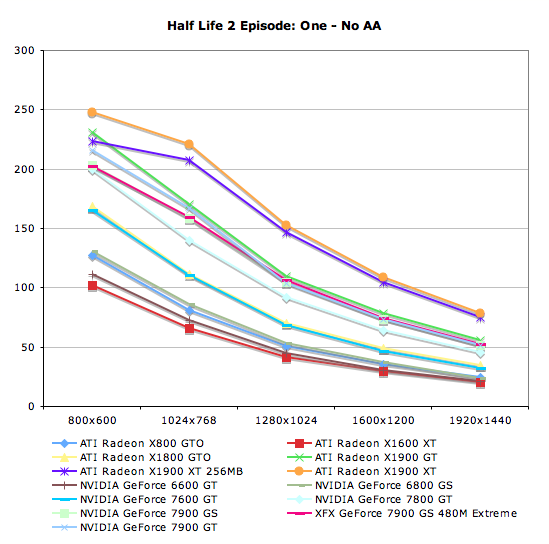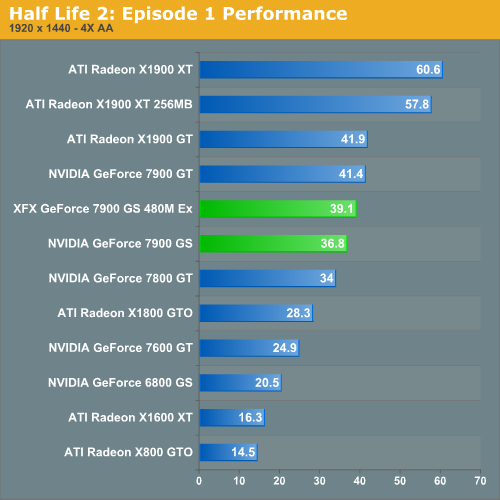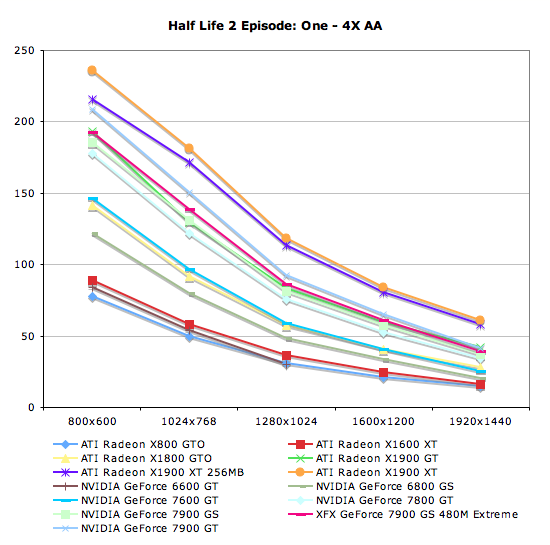Fall '06 NVIDIA GPU Refresh - Part I: GeForce 7900 GS
by Derek Wilson on September 6, 2006 9:00 AM EST- Posted in
- GPUs
Half-Life 2: Episode One Performance
Episode One of the new Half-Life 2 series makes use of recent Source engine updates to include Valve's HDR technology. While some people have done HDR that won't allow antialiasing (even on ATI cards), Valve put a high value on building an HDR implementation that everyone can use with whatever settings they want. Consistency of experience is usually not important enough to developers who care about pushing the bleeding edge of technology, so we are very happy to see Valve going down this path.
We use the built-in timedemo feature to benchmark the game. Our timedemo consists of a protracted rocket launcher fight and features much debris and pyrotechnics. The source engine timedemo feature is more like the nettimedemo of Id's Doom 3 engine, in that it plays back more than just the graphics. In fact, Valve includes some fairly intensive diagnostic tools that will reveal almost everything about every object in a scene. We haven't found a good use for this in the context of reviewing computer hardware, but our options are always open.
The highest visual quality settings possible were used including the "reflect all" setting which is normally not enabled by default, and anisotropic filtering was set at 8x. While the Source engine is notorious for giving great framerates for almost any hardware setup, we find the game isn't as enjoyable if it isn't running at at least 30fps. This is very attainable even at the highest resolution we tested on most cards, and thus our target framerate is a little higher in this game than others.

Under Half-Life 2 with Valve's HDR enabled, ATI rises to the top. The X1900 GT shows a sustainable advantage across the board. Of course, all of these cards are playable at the highest settings. The value of a few frames per second is completely up to the end user, but a narrow margin of victory is not as important with the Source engine as it in other cases.

| Half Life 2: Episode One - No AA | |||||
800x600 |
1024x768 |
1280x1024 |
1600x1200 |
1920x1440 |
|
| ATI Radeon X800 GTO | 126.9 |
81.2 |
50.4 |
35.1 |
24.3 |
| ATI Radeon X1600 XT | 102.3 |
65.8 |
41 |
29.1 |
20.4 |
| ATI Radeon X1800 GTO | 168.9 |
111.2 |
69.6 |
48.7 |
34.2 |
| ATI Radeon X1900 GT | 231.1 |
170.6 |
109.7 |
78.4 |
55.5 |
| ATI Radeon X1900 XT 256MB | 223.4 |
206.9 |
146.7 |
104.8 |
74.9 |
| ATI Radeon X1900 XT | 247.7 |
220.9 |
152.6 |
109.1 |
78.2 |
| NVIDIA GeForce 6600 GT | 110.9 |
72.1 |
44.7 |
30.6 |
20.9 |
| NVIDIA GeForce 6800 GS | 130.4 |
86.3 |
53.4 |
37.2 |
23.8 |
| NVIDIA GeForce 7600 GT | 164.8 |
110 |
68.1 |
46.6 |
32.3 |
| NVIDIA GeForce 7800 GT | 200.1 |
140 |
92 |
64.1 |
45.2 |
| NVIDIA GeForce 7900 GS | 203 |
158.3 |
104.5 |
73 |
51 |
| XFX GeForce 7900 GS 480M Extreme | 202.6 |
159.2 |
105.8 |
74.2 |
52.2 |
| NVIDIA GeForce 7900 GT | 216.1 |
166.9 |
103.9 |
73.2 |
51 |

Interestingly, when we enable AA, NVIDIA becomes more competitive. This is not usually the case, and especially not with HL2. At higher resolutions, ATI's X1900 GT does retake the performance lead from the overclocked 7900 GS, but even the stock 7900 GS remains competitive up through 1600x1200.

| Half Life 2: Episode One - 4X AA | |||||
800x600 |
1024x768 |
1280x1024 |
1600x1200 |
1920x1440 |
|
| ATI Radeon X800 GTO | 77.5 |
49.7 |
30.5 |
21.3 |
14.5 |
| ATI Radeon X1600 XT | 89.2 |
57.8 |
36.4 |
24.5 |
16.3 |
| ATI Radeon X1800 GTO | 141.3 |
91.4 |
57.7 |
40.4 |
28.3 |
| ATI Radeon X1900 GT | 193.1 |
129.8 |
83.3 |
59.6 |
41.9 |
| ATI Radeon X1900 XT 256MB | 215.8 |
171.6 |
113.5 |
80.3 |
57.8 |
| ATI Radeon X1900 XT | 235.8 |
181.4 |
118.5 |
84.2 |
60.6 |
| NVIDIA GeForce 6600 GT | 83.7 |
54.1 |
30 |
||
| NVIDIA GeForce 6800 GS | 121.6 |
79.9 |
48.5 |
33.6 |
20.5 |
| NVIDIA GeForce 7600 GT | 146.7 |
96.4 |
58.6 |
40.4 |
24.9 |
| NVIDIA GeForce 7800 GT | 177.6 |
121.5 |
75.5 |
52.8 |
34 |
| NVIDIA GeForce 7900 GS | 185.7 |
131 |
81.3 |
57.1 |
36.8 |
| XFX GeForce 7900 GS 480M Extreme | 192.5 |
139 |
86.4 |
60.8 |
39.1 |
| NVIDIA GeForce 7900 GT | 208.7 |
150.4 |
92.1 |
65 |
41.4 |










29 Comments
View All Comments
munky - Wednesday, September 6, 2006 - link
FEAR is a DX9 game, not OpenGL...
DerekWilson - Wednesday, September 6, 2006 - link
I'm looking into this at the moment but having trouble finding documentation on it.I suppose, as I was recently testing quad sli and saw huge performance increases, I assumed the game must be using the 4 frame afr mode only possible in opengl (dx is limited to rendering 3 frames ahead). I'll keep looking for confirmation on this ...
MemberSince97 - Wednesday, September 6, 2006 - link
Jupiter EX is a DX9 rendering engine...DerekWilson - Wednesday, September 6, 2006 - link
corrected, thanks ... now I have to figure out why FEAR likes quad sli so much ...MemberSince97 - Wednesday, September 6, 2006 - link
Nice writeup DW, I really like the mouseover performance % graphs...PrinceGaz - Thursday, September 7, 2006 - link
So do I, but there is one errorThat should be 14% and 25% advantages
The 7900GS has 20 PS while the 7900GT has 24 PS. That makes the 7900GS 20% slower than the 7900GT, but it makes the 7900GT 25% faster than the 7900GS. It's important to remember which one you're comparing it against when quoting percentages.
Hopefully the percentage performance difference in the graph itself was calculated correctly, or at least consistently.
PrinceGaz - Thursday, September 7, 2006 - link
Ooops sorry, please ignore my post. For some reason I thought for a moment the 7900GS had 16 PS and the 7900GT had 20 PS (despite writing the correct values in my comment). The article is correct, I was just getting confused.PS. an edit function would be nice.
Frackal - Wednesday, September 6, 2006 - link
There is no way an X1900xt gets 75fps at 1600x1200 4xAA, at that same resolution and AA setting I get well over 120-130fps average with an X1900xtx. Most sites show it hitting at least 100+DerekWilson - Wednesday, September 6, 2006 - link
if you use the built in demo features to run a timedemo with dice's own calculations you will get a very wrong (skewed upward) number. Dice themselves say that results over 100 fps aren't reliable.the problem is that they benchmark the load screen, and generally one card or the other will get better load screen performance -- for instance, the x1900 gt may get 300+fps while the 7900 gt may only get 200fps. (I just picked those numbers, but framerates for the load screen are well over 100 fps in most cases and drastically different between manufacturers).
not only does no one care about this difference on a load screen, but it significantly interferes with benchmark numbers.
the timedemo feature can be used to output a file with frametimes and instantaneous frames per second. we have a script that opens this file, removes the frame data for the load screen, and calculates a more accurate framerate average using only frame data for scenes rendered during the benchmark run.
this will decrease over all scores.
we also benchmark in operation clean sweep which has a lot of fog and water. we use a benchmark with lots of smoke and explosions and we test for some ammount of time in or near most vehicles.
splines - Wednesday, September 6, 2006 - link
Ownage approved.